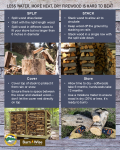Many Idaho residents use wood as their primary or secondary heat source. However, smoke from fireplaces and woodstoves contains fine particle pollution, which is one of the most serious air quality problems in Idaho. These tiny, microscopic particles can enter the bloodstream and cause breathing and heart problems.
According to EPA, a single old, inefficient woodstove can emit as much air pollution as five old diesel trucks. Woodsmoke contains harmful substances such as benzene, methane, formaldehyde, acrolein, carbon monoxide, carbon dioxide, nitrogen oxide, and tiny particulate matter. Many of these are linked to cancer and cause or aggravate lung and heart disease.
Burn Right
Best burning practices can be used to improve the heat efficiency of the stove and reduce the amount of smoke from your chimney. Follow these steps for a cleaner-burning stove and use the links in the Videos and Resources for methods to improve the operation of your stove.
Never burn the following items:
- Household trash, including cardboard, plastics, foam, or colored ink on magazines, boxes, and wrappers
- Coated, painted, and pressure-treated wood
- Ocean driftwood, plywood, particleboard, or any wood treated with glue
- Wet, rotted, diseased, or moldy wood
- Plastic, asbestos, rubber, manure, or animal remains
This accordion will not appear on the screen
Get the optimal efficiency and heat from your woodstove by only burning dry wood with a moisture content of less than 20%. Follow these steps to get the most out of your woodstove and click the graphic to learn more:
- Split the wood in a range of sizes to fit your stove but no wider than 6-inch wedges.
- Stack wood to allow for air to circulate.
- Cover the top of the stack to protect it from rain or snow.
- Store and allow 6 to 12 months to dry.
An efficient fire for your woodstove requires the right amount of dry wood and proper fire-building techniques. Use only dry wood and build smaller, hotter fires that provide sufficient airflow. Don’t let your fire smolder. Start fires with newspaper, dry kindling, or all-natural fire starters. The Hearth, Patio, and Barbecue Association developed a video demonstrating the five rules to follow for an efficient fire.
Fire officials recommend getting your woodstove appliance, chimney, and vent professionally inspected annually to ensure that it is operating safely. Cleaning chimneys at least once a year will prevent creosote buildup and avoid chimney fires.
New woodstove technology can help reduce emissions. New EPA standards, in effect starting in 2020, reduce particulate emissions by almost 50% from stoves built after 2015 and by almost 70% from stoves built before 2015. All stoves sold by retailers or manufactures must be EPA-certified. Look for the EPA certification label on the back of the stove to determine when your stove was manufactured. If your stove does not have a certification label, it was built before 1988.
EPA maintains a list of certified woodstoves. Talk with an experienced hearth retailer for information on product performance and to determine the best appliance for you. Financial resources are available to help with the cost of woodstove upgrades.
Have your new woodstove professionally installed with the proper venting system as described in your owner’s manual. Experienced professionals can also ensure that the stove is properly sized and located for optimal heat distribution. Correct installation reduces wood consumption, produces more usable heat, and reduces maintenance from inefficient fires.
- How to Build a Firewood Storage Shed
- Split, Stack, Cover, Store: Four Simple Steps to Drying Firewood video
- Learn about the heating benefits of burning dry wood video
- The Hearth, Patio, and Barbecue Association (HPBA) woodstove video series
- Choosing the right wood-burning stove
- Financial resources to update your woodstove


